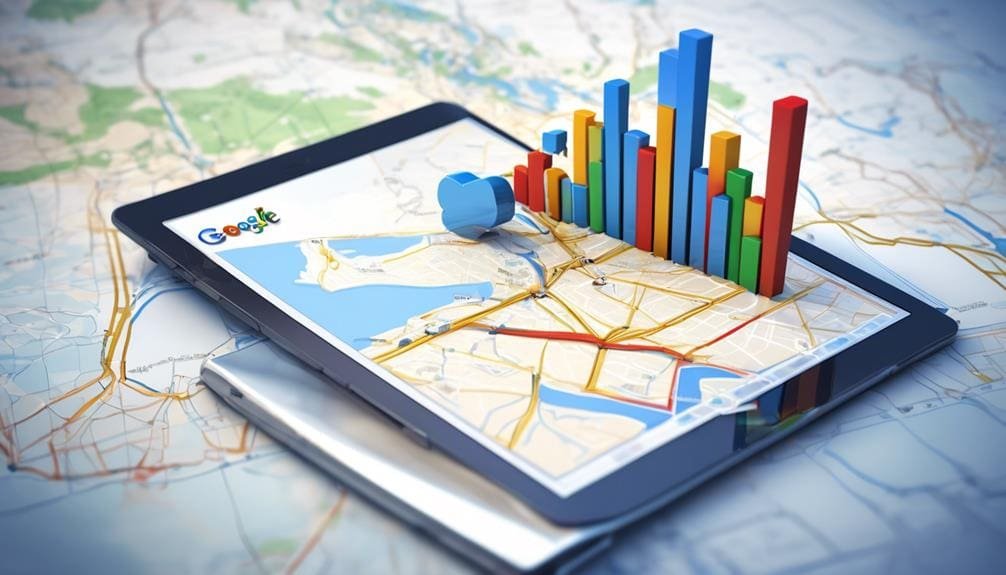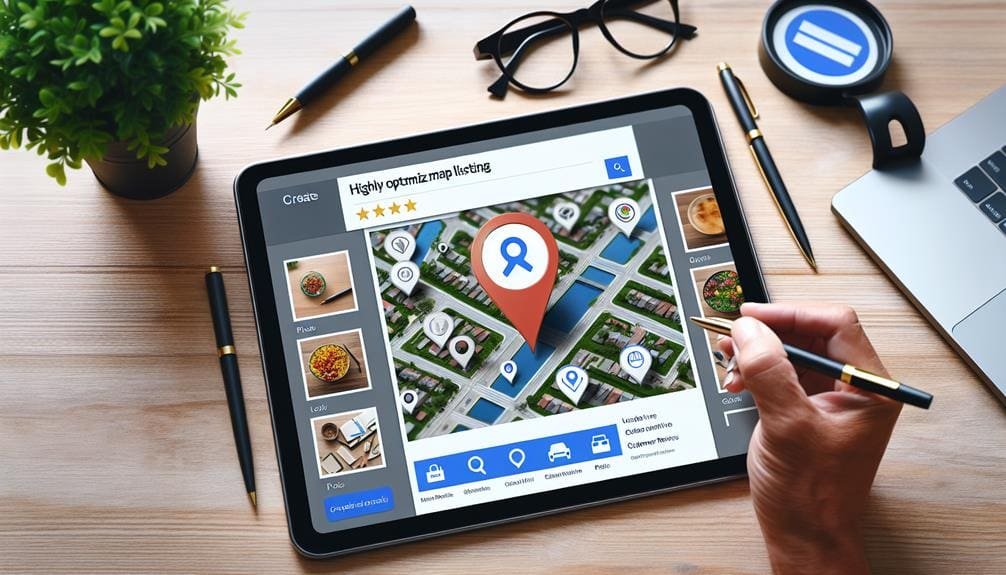10 Best Tactics to Climb Google Maps Rankings
February 4, 2024 | by Jacob Cavazos

As navigators in the vast ocean of digital competition, we understand that a strong presence on Google Maps is akin to a lighthouse guiding potential customers to our shores. We've charted a course based on robust data analysis to reveal the 10 best tactics that can propel a business up the Google Maps rankings. These strategies aren't just theories; they're practical, SEO-focused moves that we've seen work. From optimizing your business profile for maximum impact to leveraging the power of customer reviews, our approach is methodical and results-oriented. We'll discuss the significance of local keywords, the advantages of embedding Google Maps on your site, and the importance of regularly updating your listing details. By the time we've navigated through all these tactics, you'll have a comprehensive understanding of how to make your mark on the map. But before we set sail on this journey, let's anchor down on one critical aspect: the influence of quality local backlinks—and that's just the tip of the iceberg.
Optimize Your Business Profile
To effectively climb Google Maps rankings, it's crucial to start by verifying and optimizing your Google My Business listing, ensuring every detail is precise and up-to-date. A comprehensive and accurate Google Business Profile is the cornerstone of local SEO success. We must ensure our NAP is consistent and accurate across all online platforms. This uniformity signals to Google the legitimacy of our business, which is a significant factor in ranking on Maps.
We've got to stay on top of review management as well. Positive customer reviews not only boost our credibility but also influence our Google Maps visibility. Actively encouraging feedback and responding to reviews demonstrates to Google that we value customer interaction and are a current, active business.
Let's not forget, consistently updating our profile with fresh content like posts and photos increases engagement, which Google rewards with higher visibility. It's a simple formula: Verified listing plus consistent NAP plus active review management equals improved Google Maps rankings. We need to implement these tactics meticulously to dominate local search results and outperform competitors.
Encourage Customer Reviews

We understand the power of customer reviews in boosting our Google Maps rankings, so we're proactive in encouraging our customers to share their feedback. By implementing strategies that prompt users to leave testimonials, we're able to enhance our online visibility and credibility. We've seen that consistently responding to reviews, whether they're positive or negative, significantly improves customer engagement and our service's perceived value.
Leverage User Testimonials
Harnessing the power of customer reviews can significantly boost your Google Maps visibility, as detailed and positive testimonials serve as strong signals of credibility to both potential customers and Google's ranking algorithms. We know that:
- Positive reviews
- Improve local SEO rankings
- Enhance trust and social proof
- Increase click-through rates
- Review requests
- Should be timely and personalized
- Can be automated for efficiency
- Must comply with Google's guidelines
- User experience
- Is reflected in the content of reviews
- Can be optimized based on feedback
- Influences future customer expectations
We're committed to leveraging user testimonials to not only climb the rankings but also to refine our user experience continually. Our strategy includes active review requests and showcasing these powerful endorsements across our digital presence.
Implement Review Strategies
Building on the foundation of user testimonials, let's now focus on implementing review strategies that encourage customers to actively share their experiences on our Google Maps listing. Actively engaging with and responding to customer reviews is a critical component of local SEO. It not only showcases our commitment to customer satisfaction but also signals to Google the relevance and authenticity of our business.
Here's a strategic approach we can use:
| Strategy | Benefit for Local SEO |
|---|---|
| Respond to Reviews | Boosts Engagement |
| Incentivize Reviews | Increases Visibility |
| Regularly Monitor | Maintains Reputation |
Utilize Local Keywords

Incorporating local keywords into your Google Maps business listing can significantly boost your visibility to potential customers searching in your specific geographic area. As we delve into the nuances of local SEO, we understand the imperative role of local keywords in climbing the Google Maps rankings.
- Optimize with Local Terms
- Business Description: Integrate location-specific terms that resonate with local search patterns.
- Services and Products: Align your offerings with what locals are searching for by using relevant local keywords.
- Neighborhood and City Names: Mentioning your business's proximity to well-known areas can attract nearby customers.
- Enhance with Landmarks
- Local Landmarks: Incorporate landmarks or popular spots in your keywords to signal immediate relevance.
- Directional Cues: Use terms like "near" or "between" followed by landmarks to help people locate your business.
- Connect with Local Culture
- Slang and Colloquialisms: Employing local slang in your listing can forge a stronger connection with the community.
- Local Events: Reference events or festivals in your area to show engagement and increase relatability.
We're targeting an audience that craves mastery, so let's leverage these insights to outmaneuver competitors in local search results. By precisely using local keywords, we're not just improving SEO—we're becoming an integral part of the local community's online experience.
Embed Google Maps on Your Site

We often overlook the simple yet powerful tactic of embedding a Google Map on our website, a move that can significantly enhance the user's experience and serve as a clear, interactive guide to our location. Embedding a Google map on the contact us page not only aids in navigation but also contributes directly to our SEO efforts. It signals to Google the exact location of our business, which can improve our visibility in local search results.
Here's a quick guide to effectively integrate Google Maps on your site:
| Step | Action |
|---|---|
| 1 | Locate your business on Google Maps. |
| 2 | Click on the 'Share' button and select 'Embed a map'. |
| 3 | Choose the appropriate size for the map and copy the HTML code. |
| 4 | Paste the code into the HTML of your contact us page. |
| 5 | Ensure the map is responsive for mobile users. |
Regularly Update Listing Details

We've seen that keeping our Google Maps listing meticulously up-to-date boosts our visibility and ranking. By promptly updating operational hours and reflecting any service changes, we signal to Google that our information is current and reliable. Additionally, taking advantage of Google Maps' special features, like posts for promotions or events, can engage users and further enhance our profile's effectiveness.
Accurate Operational Hours
Ensuring your Google Maps listing reflects accurate, up-to-date operational hours is a crucial step in maintaining high visibility and trustworthiness in local search rankings. We recognize the significance of accurate operational hours as a cornerstone for climbing Google Maps rankings. Here's how you can master this:
- Update your NAP (Name, Address, Phone number)
- Regularly verify your business information
- Ensure consistency across all platforms
- Accurate Operational Hours
- Adjust for holidays and special events
- Communicate temporary changes promptly
- Business Information Integrity
- Prevent customer dissatisfaction
- Enhance user experience and credibility
Reflect Service Changes
Building on the foundation of accurate operational hours, it's equally vital to keep your Google Maps listing current by regularly updating service details and business information. As we refine our business search listing, updating through Google My Business becomes a strategic necessity. Any changes in contact information, services offered, or adjustments in business hours must be promptly reflected to maintain trust and facilitate user access.
Moreover, consistently adding fresh photos and content not only enhances engagement but also signals to Google that our listing is active and relevant. Leveraging Google Posts allows us to communicate updates directly and efficiently. Adopting these updates as routine ensures our listing remains a reliable resource, thus improving our visibility and favorability in rankings.
Utilize Special Features
To boost our Google Maps presence, it's crucial to regularly update our listing with engaging posts, vivid photos, and detailed descriptions that capture user interest and increase activity. Here's how we can effectively leverage these special features:
- Google Posts
- Share updates, offers, and events
- Link to recent blog posts for added SEO benefits
- Engage with local audiences by highlighting community involvement
- Visuals
- Add photos that showcase our services and products
- Update imagery to reflect seasonal changes or new offerings
- Use high-quality images to stand out in local directories and resources
- Accurate Information
- Embed a Google Map on our contact page
- Ensure phone numbers are tracked for optimization
- Regularly verify location details for user trust and credibility
Post Relevant Local Content

Posting relevant local content on Google Maps can significantly increase your business's visibility and attract a targeted local audience. We understand that a strong local presence isn't just about being on the map; it's about weaving our business into the fabric of the community. By sharing local news stories that resonate with our customers, we position ourselves as a valuable information resource, not just a service provider.
We're strategic in our approach, ensuring each piece of content is optimized for search engines. This means using relevant keywords tied to local events and happenings that our audience cares about. We're not just posting; we're building a narrative that links our business with the local identity.
Moreover, we're proactive in sponsoring local events and broadcasting these partnerships through Google Maps. This not only enhances our local SEO efforts but also demonstrates our commitment to the community. It's a synergy that drives both foot traffic and online clicks.
We keep our content fresh with regular updates on offers and promotions. High-quality photos give a visual appeal, while links to our primary product or service pages funnel users directly to our website, improving our overall rankings. Every action is calculated for maximum SEO impact.
Build Quality Local Backlinks

To climb the Google Maps rankings, we must focus on securing quality local backlinks. By engaging with local influencers and actively participating in community events, we can generate authoritative links that signal relevance to our geographical area. These strategies, backed by data, not only enhance our local SEO but also connect us with the heart of our community.
Identify Local Influencers
By partnering with local influencers, we can significantly boost our Google Maps ranking through the acquisition of high-quality local backlinks. Here's how we strategically engage:
- Engage with Local Entities
- Businesses: Partner for joint promotions or features.
- Organizations: Participate in community events for visibility.
- News Outlets: Obtain mentions in local stories.
Our focus remains on securing follow links from relevant, authoritative sources. This not only elevates our local SEO efforts but ensures our presence is solidified within the digital marketing landscape. Utilizing social media effectively, we collaborate with local influencers who have a robust following, enhancing our backlink profile and driving targeted local traffic to our site. Mastery in this tactic is non-negotiable for a dominant Google Maps presence.
Participate in Community Events
Building on our strategy of engaging with local influencers, we're taking our efforts to the streets by actively participating in community events, a move that not only fosters genuine connections but also earns quality local backlinks to boost our Google Maps ranking.
| Strategy | Benefit |
|---|---|
| Engage with local organizations | Establishes authority & gains backlinks |
| Sponsor community events | Enhances local visibility & reputation |
| Partner with local businesses | Demonstrates local relevance |
| Promote linked content | Attracts backlinks from local media |
We're focusing on creating partnerships with local service organizations and businesses that resonate with our brand. By doing so, we ensure our backlinks come from relevant and respected sources. It's not just about quantity; the caliber of our local backlinks is a driving force in our climb up the Google Maps rankings.
Can the strategies for climbing local map listings also be applied to climbing Google Maps rankings?
Yes, the strategies for climbing local map listings can also be applied to climbing Google Maps rankings. Implementing strong keyword optimization, gaining positive customer reviews, and updating business information can all help improve local map visibility across various platforms.
Manage and Respond to Reviews

Monitoring and responding to reviews on your Google Business Profile is essential for improving customer engagement and boosting your visibility in search rankings. The data shows that businesses that actively engage with their reviewers can see significant improvements in their Google Maps rankings. Here's what we need to focus on:
- Encourage Customers to Leave Reviews
- Make it easy: Offer quick links or QR codes.
- Incentivize: Consider rewards for those who leave reviews.
- Follow up: Send a polite reminder post-purchase or visit.
- Respond to Reviews Promptly
- Acknowledge: Thank customers for positive feedback.
- Address: Tackle the number of negative reviews head-on with professionalism.
- Rectify: Offer solutions to any issues raised.
- Leverage Reviews for SEO
- Keywords: Incorporate relevant keywords in your responses.
- Fresh content: Regular responses mean updated content, which search engines favor.
- Local SEO: Tailor responses to highlight local features or offerings.
We can't afford to overlook the power of reviews. It's not just about the sheer volume; it's the quality of our interactions that can turn a casual browser into a loyal customer. Let's make sure we're on top of our game and respond to reviews with the expertise and attentiveness they deserve.
Use Google My Business Features

Having established the importance of managing reviews, let's now focus on optimizing our use of Google My Business features to further enhance our local SEO and Maps visibility. To begin with, we're committed to regularly updating our Google Business Profile. Fresh content and images are a signal of activity that Google rewards, aiding in ranking higher on Google Maps.
We also recognize the significance of using a local phone number for verification. This not only establishes the authenticity of our location but also boosts the credibility of our Google Maps business listings. Consistency is key; therefore, we ensure that our name, address, and contact information are uniform across all online platforms, building trust with both users and search algorithms.
We've found that embedding a Google Map on our contact page not only improves user experience but could also positively impact our rankings. Lastly, community engagement is part of our strategic approach. By sponsoring local events and gaining mentions in local news, we establish our business as a local authority, which is instrumental in boosting our visibility on Google Maps.
Analyze Ranking Performance

To stay ahead in the competitive landscape of local search, we regularly analyze our ranking performance using insights from Google Search Console and Google Analytics. It's essential that we're data-driven in our approach—after all, what gets measured gets managed.
Here's how we dive deeper into the analytics:
- Search Console Insights
- *Keyword Analysis*: We identify which search queries are most effective for our Google Maps ranking.
- *Search Visibility*: Monitoring how often our site appears in search results informs us about our visibility.
- *Click-Through Rates (CTR)*: High CTR indicates our listings are compelling to users.
- Google Analytics Metrics
- *User Behavior*: We assess how visitors interact with our website after clicking through from Google Maps.
- *Conversion Tracking*: Understanding which local searches lead to conversions is key to our strategy.
- *Bounce Rate*: Lower bounce rates suggest our content is relevant to the user's needs.
- Competitive Analysis
- *Benchmarking*: We compare our performance against competitors to identify where we can improve.
- *Market Trends*: Adapting to search trends keeps us ahead of the curve.
- *Ranking Fluctuations*: We track our ranking changes to gauge the effectiveness of our SEO efforts.
Mastering these tactics ensures our Google Maps ranking reflects the quality of our business. By being meticulous with our ranking performance analysis, we're able to make informed decisions that drive real results.
Frequently Asked Questions
How Do I Improve My Google Map Ranking?
We're boosting our Google Maps presence by managing reviews, optimizing our profile, and increasing local citations. This strategy's data-driven and SEO-focused, aiming for mastery in attracting and retaining our targeted local audience.
How Do You Climb Google Rankings?
We're enhancing our local SEO, managing reviews meticulously, and building citations to climb Google rankings, employing data-driven strategies for mastery in search engine optimization.
How to Improve Your Google Rankings Without Getting Penalized?
We'll improve our Google rankings by mastering local SEO, ensuring citation consistency, and meticulously managing reviews, adopting data-driven strategies that safeguard against penalties while enhancing our online visibility and authority.
How Do I Dominate Google Maps?
We're climbing the digital ladder with savvy profile optimization, meticulous local citations, and strategic review management to dominate Google Maps and ensure our mastery is seen, felt, and validated by data-driven, SEO-focused techniques.
RELATED POSTS
View all



